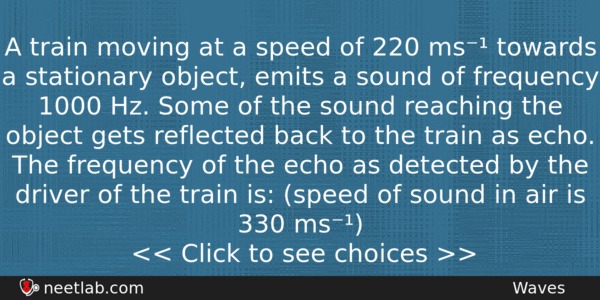| ⇦ | 
| ⇨ |
A train moving at a speed of 220 ms⁻¹ towards a stationary object, emits a sound of frequency 1000 Hz. Some of the sound reaching the object gets reflected back to the train as echo. The frequency of the echo as detected by the driver of the train is: (speed of sound in air is 330 ms⁻¹)
Options
(a) 3500 Hz
(b) 4000 Hz
(c) 5000 Hz
(d) 3000 Hz
Correct Answer:
5000 Hz
Explanation:
Frequency of the echo detected by the driver of the train is (According to Doppler effect in sound)
f’ = (v + u / v – u) f
where, f = original frequency of source of sound
f’ = Apparent frequency of source beacause of othe relative motion between source and observer.
f’ = (330 + 220 / 330 – 220) 1000 = 5000 Hz.
Related Questions: - A uniform force of (3i+j) Nacts on a particle of mass 2 kg.Hence the particle is displaced
- A particle of mass m, charge Q and kinetic enery T enters a transverse
- The physical quantities not having same dimensions are
- When npn transistor is used as an amplifier
- The most stable particle in Baryon group is
Topics: Waves
(80)
Subject: Physics
(2479)
Important MCQs Based on Medical Entrance Examinations To Improve Your NEET Score
- A uniform force of (3i+j) Nacts on a particle of mass 2 kg.Hence the particle is displaced
- A particle of mass m, charge Q and kinetic enery T enters a transverse
- The physical quantities not having same dimensions are
- When npn transistor is used as an amplifier
- The most stable particle in Baryon group is
Topics: Waves (80)
Subject: Physics (2479)
Important MCQs Based on Medical Entrance Examinations To Improve Your NEET Score
18000+ students are using NEETLab to improve their score. What about you?
Solve Previous Year MCQs, Mock Tests, Topicwise Practice Tests, Identify Weak Topics, Formula Flash cards and much more is available in NEETLab Android App to improve your NEET score.
Share this page with your friends

Leave a Reply